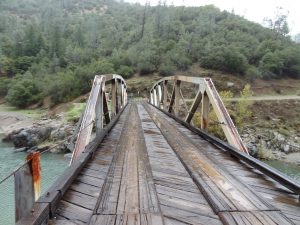Final Thoughts: Bridge Work: From Wooden Covers to Recycled Steel

As I was previewing this issue of Informed Infrastructure, I came across a brief summary of an article about the engineering of tall wood buildings. Although I’m not quite old enough to have designed any covered bridges, I have some experience with wooden-bridge structures.
Readers may recall from previous “Final Thoughts” columns that I spent the early part of my career with the Indiana Department of Transportation in the Bridge Design Section. During my time there, the department still had a number of timber bridges on the state system. One of the assignments for the bridge section was to develop a plan to remove these structures from the highway system, but still preserve the history.
Typically, this meant that an inspection and structural analysis was made with the intent of retiring the bridge from use and transferring ownership to local government authority. Occasionally, some minor repairs were made—usually replacing portions in kind. Most of the time, the highway was just rerouted slightly, or the bridge was carefully relocated along with the creation of a historical site and marker. As a result, there are approximately 100 preserved covered bridges in Indiana, according to a brief internet search. If you’re in that area, take a drive to view some fascinating and beautiful Midwest history.
Bridge Replacement
My closer experience with timber and bridges has to do with replacing timber bridges. Typically, it was determined that there was no economical method of repairing or widening a timber bridge, and if there was no historical value, the policy was simply to replace the structure.
If I remember correctly, I was involved in about three or four replacements of timber bridges. One caught on fire due to an accident underneath the bridge. The timber beams became significantly charred, but the bridge held. It was estimated that due to the temperature of the fire beneath, steel beams would have melted and deformed to the point of structural failure.
Most of my experience with timber in bridges was in replacing timber decks on steel truss bridges. The decks normally consisted of cross members (perpendicular to the centerline of roadway) resting on and fastened to the steel stringers between the floorbeams. Longitudinal runners provided the riding surface (at right).
Sometimes these timber decks could be replaced with concrete floors if the superstructure could handle the additional dead load. In a few occasions, where the bridge was scheduled to be replaced in the near future, the timber deck was replaced with a new timber deck.
This was a learning experience for us as young engineers. What’s the strength of various types of wood? Should the wood be treated? How are the boards connected to the stringers and floorbeams? The answers to these questions were discussed in one of my classes in college, but I never thought I would actually need that information.
I’m grateful for the experience I gained with timber in the bridge-design business. Although it wasn’t very deep, it offered unique opportunities to be a part of history.
Is there a future for more bridge construction using wood? Currently, there are a number of companies fabricating laminated wood beams that can and are used in bridge construction. I encourage readers to keep that option in mind when designing a bridge, especially in an area where the bridge will fit in with the surrounding area.
Sustainable Materials
In the United States, structural steel is made from more than 90 percent of recycled materials. Part of the new bridge you recently drove over used to be a 1982 Buick Riviera and a refrigerator. I have told this statistic to many people, and all of them were surprised. As a profession, we should be proud of that fact, and we should spread it around more frequently.

The Ponderosa Way Bridge in Placer County, Calif., was built in 1935. Note the longitudinal timbers serving as the riding surface over the transverse (skewed) timbers.
I hope technology allows for greater use of sustainable materials, adding to our “greener” infrastructure. As we continue to create buildings and bridges, I’m confident our profession will continue to be a leader in the use of sustainable materials.
About Robert Schickel
Robert Schickel was born in New Jersey and received his BS in Civil Engineering degree in 1971 from Valparaiso University in Indiana. His career started as a bridge design engineer and expanded to include design of various transportation facilities, including highways, bridges, rail lines and stations, and airport runways. Mr. Schickel managed engineering offices ranging from 20 to 140 people. He also served as a consultant to a large utility company. Mr. Schickel currently resides in Indiana and serves as Adjunct Professor for the College of Engineering at Valparaiso University. He enjoys his retired life at his lake house, playing golf, listening to music and spending time with his family, especially his grandchildren.


